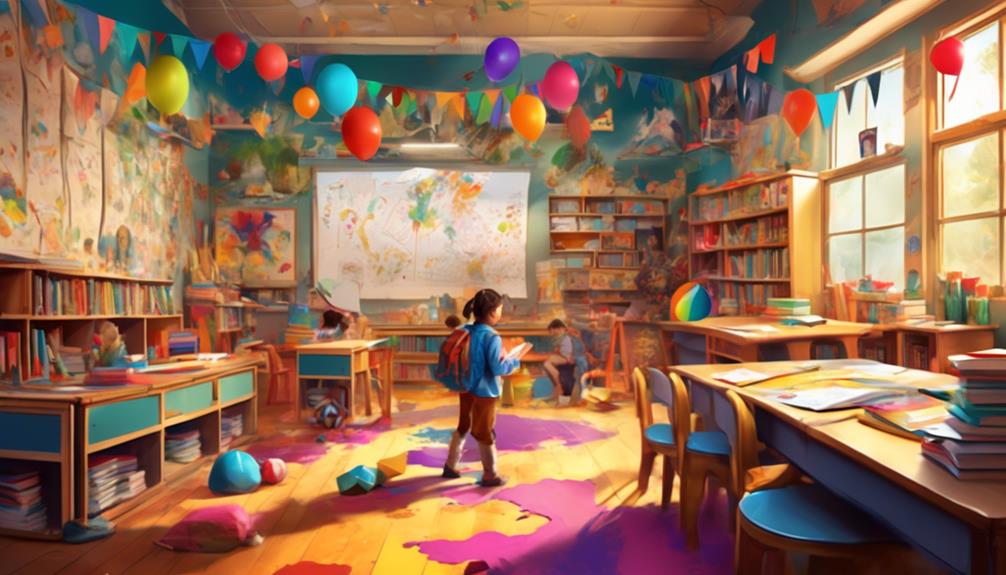How to Foster a Love of Learning in Children

Practical strategies to foster a love of learning in children:
- Creating a positive learning environment.
- Encouraging curiosity and exploration.
Creating a positive learning environment involves making sure that children feel safe, supported, and valued in their learning environment. This can be achieved by establishing clear expectations and routines, providing a comfortable and organized space for learning, and cultivating a positive and respectful atmosphere among students and teachers.
Encouraging curiosity and exploration is another important strategy. This can be done by providing opportunities for hands-on learning experiences, incorporating real-world examples and connections into lessons, and fostering a sense of wonder and excitement about learning. It is also essential to allow children to ask questions, explore their interests, and pursue their own lines of inquiry.
By implementing these strategies, parents and educators can help children develop a love of learning that will serve them well throughout their lives.
Establish a Positive Learning Environment
To foster a love of learning in children, it's crucial to create a positive learning environment that encourages curiosity and engagement. One way to establish a positive learning environment is by establishing routines. Routines provide structure and predictability, which can help children feel safe and secure. By having consistent routines for things like morning arrival, transitions, and end of the day, children know what to expect and can focus on learning without worrying about what comes next.
In addition to routines, creating a safe space is essential for a positive learning environment. Children need to feel physically and emotionally safe in order to fully engage in their learning. This can be achieved by providing a welcoming and supportive classroom environment where students feel comfortable taking risks and making mistakes. Displaying student work, incorporating cozy reading corners, and encouraging open communication can all contribute to creating a safe space for learning.
Encourage Curiosity and Exploration
Ready to unleash your child's natural curiosity?
Encouraging curiosity and exploration is key to fostering a love of learning. By embracing their inquisitiveness and supporting open-ended exploration, you can create an environment that nurtures their desire to discover, inquire, and learn.
Embrace Natural Inquisitiveness
Encouraging curiosity and exploration in children is key to fostering a love of learning. Nurturing curiosity allows children to develop a natural inquisitiveness that drives their desire to explore and discover. By promoting inquiry-based learning, you're providing opportunities for children to ask questions, investigate, and find answers on their own.
Here are four ways to embrace natural inquisitiveness:
- Encourage open-ended questions: Foster a safe environment where children feel comfortable asking questions without fear of judgment. This will help stimulate their curiosity and encourage them to explore further.
- Provide hands-on experiences: Engage children in activities that require active participation. This allows them to explore and learn through discovery, promoting a deeper understanding of the world around them.
- Support independent thinking: Encourage children to think critically and problem-solve independently. This will empower them to take ownership of their learning and develop a sense of autonomy.
- Celebrate curiosity and exploration: Recognize and celebrate your child's curiosity and efforts to explore. This positive reinforcement will motivate them to continue seeking knowledge and embracing new experiences.
Support Open-Ended Exploration
Supporting open-ended exploration is essential in nurturing a child's natural curiosity and fostering a love of learning. By encouraging creative play and independent discovery, you provide opportunities for children to explore the world around them in a meaningful and engaging way.
One way to support open-ended exploration is through creative play. Encourage your child to use their imagination and engage in activities that allow them to express themselves freely. Whether it's building with blocks, creating artwork, or playing make-believe, creative play allows children to explore their interests and develop problem-solving skills.
Another way to support open-ended exploration is by promoting independent discovery. Provide your child with a variety of materials and resources that encourage exploration and experimentation. This could include books, puzzles, science kits, or even outdoor exploration tools. By allowing your child to explore and discover on their own, you empower them to take ownership of their learning and foster a sense of curiosity and self-confidence.
Supporting open-ended exploration is a powerful way to nurture a child's love of learning. By encouraging creative play and independent discovery, you give your child the tools they need to explore the world around them and develop a lifelong love of learning. So go ahead, embrace their curiosity, and watch as their love for learning grows.
| Benefits of Supporting Open-Ended Exploration | Tips for Encouraging Creative Play and Independent Discovery |
|---|---|
| Stimulates curiosity and imagination | Provide a variety of materials for creative play |
| Develops problem-solving skills | Encourage open-ended activities without strict rules |
| Fosters a love of learning | Allow for independent exploration and discovery |
| Builds self-confidence and independence | Provide opportunities for outdoor exploration and discovery |
| Enhances critical thinking and decision-making | Celebrate and encourage your child's unique interests and ideas |
Engage in Hands-On Learning Activities
Ready to take learning to the next level? Engaging in hands-on learning activities is a game-changer for children.
With interactive educational experiences and experiential learning opportunities, kids not only gain knowledge but also develop critical thinking skills, problem-solving abilities, and a deep love for learning.
Get ready to roll up your sleeves and dive into the exciting world of hands-on learning!
Interactive Educational Experiences
Get ready to dive into a world of interactive educational experiences that will captivate your child's curiosity and ignite a love for hands-on learning activities. These interactive experiences offer a dynamic and engaging way for your child to learn and explore.
Here are some exciting options to consider:
- Virtual simulations: Allow your child to step into different scenarios and environments, providing a realistic and immersive learning experience. Whether it's exploring ancient civilizations or understanding the principles of physics, virtual simulations offer a unique way for your child to engage with the subject matter.
- Gamified learning: Turn learning into a fun and interactive game. With gamified learning, your child can solve puzzles, complete challenges, and earn rewards along the way. This approach not only keeps your child engaged, but also enhances their problem-solving and critical thinking skills.
- Hands-on experiments: Encourage your child to participate in hands-on experiments that allow them to see scientific concepts come to life. From building volcanoes to conducting chemistry experiments, these activities foster a love for exploration and discovery.
- Collaborative projects: Engage your child in collaborative projects where they can work with their peers to solve problems or create something new. This not only promotes teamwork and communication skills, but also encourages creativity and innovation.
With these interactive educational experiences, your child won't only enjoy the process of learning, but also develop a lifelong love for knowledge and exploration.
Experiential Learning Opportunities
Now, let's explore the exciting world of experiential learning opportunities that will immerse your child in hands-on activities and ignite their passion for learning.
Outdoor adventures and real-world simulations are fantastic ways to engage children in interactive learning experiences that go beyond the traditional classroom setting.
Outdoor adventures provide children with the opportunity to explore and discover the natural world around them. Whether it's going on a nature hike, camping, or participating in a science expedition, these activities encourage children to observe, question, and learn about their environment firsthand. They can develop skills in map reading, navigation, and problem-solving while gaining a deeper understanding of nature and the world we live in.
Real-world simulations, on the other hand, allow children to step into different roles and scenarios, giving them a taste of what it's like to be an astronaut, a chef, or even a doctor. Through role-playing and hands-on activities, children can experience firsthand the challenges and responsibilities associated with various professions. This not only sparks their curiosity but also helps them develop essential life skills such as teamwork, communication, and critical thinking.
Incorporating outdoor adventures and real-world simulations into your child's learning journey provides them with experiential learning opportunities that are both fun and educational. So, get ready to embark on exciting adventures and watch as your child's love for learning grows with every hands-on activity they engage in.
Foster a Growth Mindset
To cultivate a love of learning in children, it's essential to nurture a growth mindset. A growth mindset encourages children to believe that their abilities can be developed through hard work, perseverance, and dedication. It fosters a belief in the power of effort and the idea that intelligence and talent can be developed over time.
Here are some ways you can foster a growth mindset in children:
- Provide opportunities for challenge and growth: Encourage children to take on tasks that are slightly beyond their comfort zone. This helps them develop resilience, problem-solving skills, and a sense of accomplishment.
- Praise effort and perseverance: Instead of solely focusing on outcomes, acknowledge and celebrate the effort and determination that children put into their work. This helps them understand that success comes from hard work and persistence.
- Teach the power of 'yet': When children say, 'I can't do it,' remind them to add the word 'yet' to the end of their sentence. This simple addition helps shift their mindset from a fixed mindset to a growth mindset, emphasizing that they're on a journey of learning and improvement.
- Encourage reflection and self-assessment: Help children develop intrinsic motivation by encouraging them to reflect on their progress and set goals for improvement. This helps them take ownership of their learning and develop a growth-oriented mindset.
Support Individual Learning Styles
One effective way to foster a love of learning in children is by supporting their individual learning styles. Every child has a unique way of processing information and understanding concepts. Some children are visual learners, while others are auditory or kinesthetic learners. By recognizing and accommodating these different learning styles, you can provide personalized instruction that helps children engage with their education and develop a lifelong love of learning.
To support different learning styles, it's important to vary your teaching methods. For visual learners, use visual aids such as charts, diagrams, and videos to help them grasp new concepts. For auditory learners, incorporate discussions, presentations, and audio recordings into your lessons. And for kinesthetic learners, provide hands-on activities and opportunities for movement to help them learn through physical experiences.
Another way to support individual learning styles is by allowing children to have some control over their learning. Give them choices in how they approach assignments or projects, allowing them to use their preferred learning style. This sense of autonomy can boost their motivation and engagement with the material.
Encourage Reading and Writing
Encouraging children to immerse themselves in the world of reading and writing is a powerful way to ignite their curiosity and instill a lifelong passion for learning. By promoting creativity and enhancing communication skills, reading and writing open up a whole new realm of possibilities for children.
Here are some ways you can encourage this love for reading and writing in your child:
- Create a reading nook: Set up a cozy and inviting space where your child can curl up with a good book. Fill the area with books that cater to their interests and let them explore different genres.
- Make it a family affair: Set aside dedicated family reading time where everyone can gather together and enjoy their own books. This not only creates a positive reading environment but also fosters a love for reading within the entire family.
- Write together: Encourage your child to write stories, poems, or even a journal. Make it a collaborative activity by sharing your own writing and providing constructive feedback. This won't only enhance their writing skills but also create a bond between you and your child.
- Visit the library: Take regular trips to the library and let your child choose their own books. This will give them a sense of ownership over their reading choices and expose them to a wide range of literature.
Emphasize the Importance of Failure and Resilience
Embracing failure and cultivating resilience are essential aspects of fostering a love of learning in children. It's important to emphasize to children that failure isn't something to be feared or avoided, but rather an opportunity for growth and learning. Resilience, on the other hand, is the ability to bounce back from failure, to persevere, and to keep trying even when faced with challenges. By teaching children the importance of resilience, we're equipping them with a valuable life skill that will help them navigate through the ups and downs of their educational journey.
When children understand that failure is a natural part of the learning process, they become more willing to take risks and try new things. They aren't afraid of making mistakes because they know that those mistakes can lead to valuable insights and knowledge. By creating a safe and supportive environment where failure is seen as an opportunity for growth, we can foster a love of learning in children.
Furthermore, it's crucial to teach children how to learn from their failures. Encourage them to reflect on what went wrong, what they could have done differently, and how they can improve in the future. By helping children develop a growth mindset and teaching them to see failures as stepping stones to success, we empower them to become resilient learners who aren't discouraged by setbacks.
Cultivate a Love for Learning Beyond the Classroom
To foster a love for learning that extends beyond the classroom, it's essential to create opportunities for children to explore their interests and passions in a hands-on and engaging way. By providing experiences that go beyond textbooks and worksheets, you can help your child develop a genuine curiosity and enthusiasm for learning.
Here are some ways to cultivate a love for learning outside of school:
- Outdoor Adventures: Encourage your child to spend time outdoors, exploring nature and discovering the wonders of the world. Whether it's going on hikes, visiting local parks, or participating in outdoor sports, these experiences can spark a sense of wonder and ignite a desire to learn more about the environment.
- Creative Expression: Provide your child with outlets for creative expression, such as art classes, music lessons, or writing workshops. These activities not only foster imagination and self-expression but also enhance critical thinking and problem-solving skills.
- Hands-on Science Experiments: Engage your child in simple science experiments that can be done at home using everyday materials. This allows them to apply scientific concepts in a practical way, encouraging a deeper understanding and appreciation for the subject.
- Field Trips and Museum Visits: Take advantage of local museums, zoos, and historical sites to expose your child to new ideas and cultures. These trips offer a chance for hands-on learning and can inspire a lifelong love of history, science, art, or any other subject they encounter.
Frequently Asked Questions
How Can Parents Create a Positive Learning Environment at Home?
You can create a positive learning environment at home by nurturing a love for learning in children. Encourage curiosity, provide engaging materials and activities, and support their interests. Show enthusiasm for their achievements and make learning fun!
What Are Some Strategies to Encourage Curiosity and Exploration in Children?
Encouraging questioning and promoting open-ended play are essential strategies to spark curiosity and exploration in children. By fostering an environment that encourages curiosity, you can inspire a love for learning that will last a lifetime.
Can You Provide Examples of Hands-On Learning Activities That Children Can Engage In?
You can engage children in hands-on learning activities like outdoor experiments and art projects. These activities not only foster a love of learning but also encourage curiosity and exploration in children.
How Can Parents Foster a Growth Mindset in Their Children?
To foster a growth mindset in your children, encourage them to embrace challenges, persist through setbacks, and believe in their ability to learn and grow. Nurturing a love for learning starts with cultivating a positive and resilient mindset.
What Are Some Ways to Support and Accommodate Different Learning Styles in Children?
To support and accommodate different learning styles in children, personalize instruction and engage them in multisensory activities. This helps them learn in ways that suit them best, fostering a love of learning through tailored experiences.











